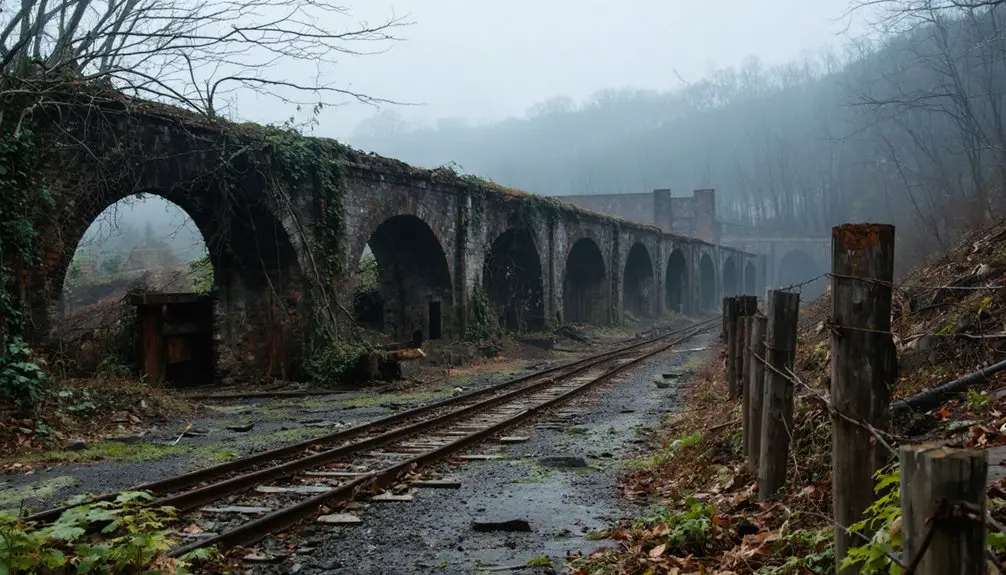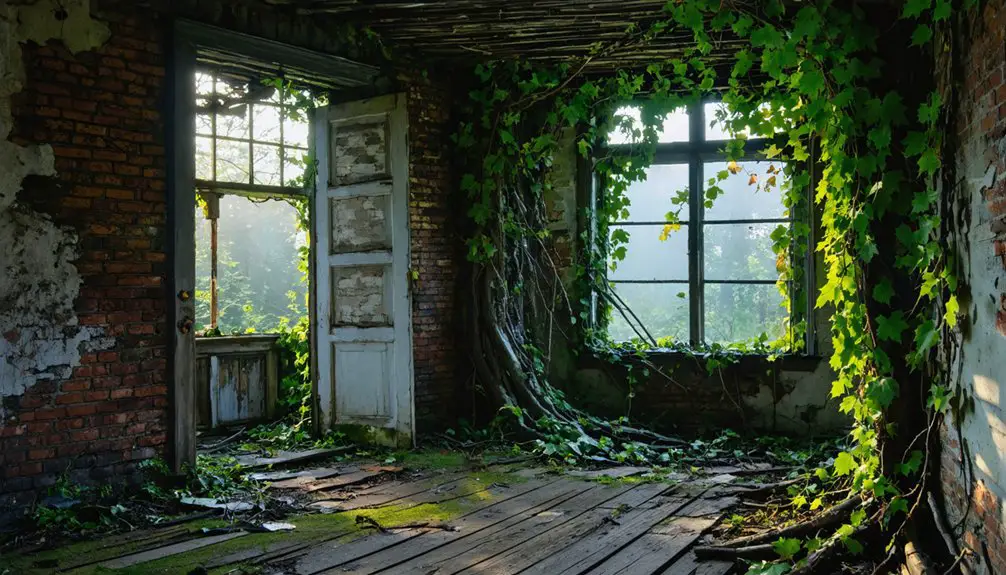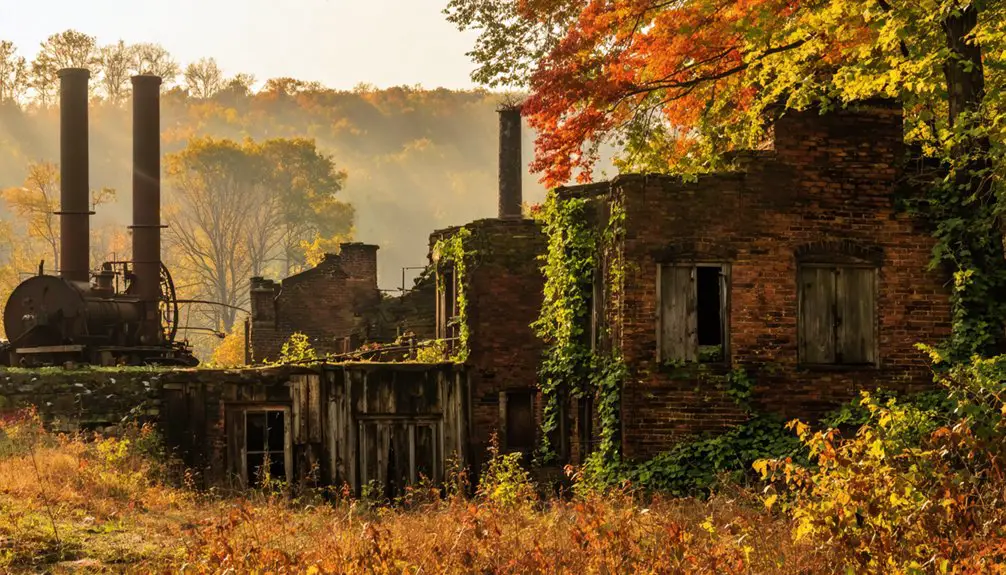You’ll encounter the haunting remains of Strights, a former anthracite mining town near Summit Hill, Pennsylvania, established in 1792 by Lehigh Coal Mine Company. The site features abandoned mine shafts, deteriorating company houses, and scattered industrial relics like rusted Caterpillar dozers and Euclid haul trucks. An underground mine fire still burns beneath the town, while nature steadily reclaims the streets where Irish and Welsh immigrants once built their lives in this quintessential Pennsylvania coal community.
Key Takeaways
- Strights was established in 1792 by Lehigh Coal Mine Company near Summit Hill, Pennsylvania as a company-owned coal mining town.
- The town experienced rapid growth during the mid-1800s due to railroad expansion and anthracite coal mining operations.
- Economic decline began in the mid-1900s when anthracite mines struggled against cheaper energy alternatives, forcing mass unemployment.
- Abandoned industrial remnants include rusted mining equipment, deteriorating homes, and massive construction machinery like Caterpillar dozers.
- An underground mine fire continues to burn beneath Strights while nature reclaims former neighborhoods with pioneer plant species.
The Rise of a Mining Community
When the Lehigh Coal Mine Company established operations in 1792 near Summit Hill, Pennsylvania, they couldn’t have known they were laying the groundwork for what would become Strights’ thriving mining community.
From humble mining operations in 1792, the seeds of Strights were planted amid Pennsylvania’s anthracite-rich hills.
Jesse Fell’s invention of the iron grate system in 1808 revolutionized how anthracite coal could be efficiently burned, making mining operations like those in Strights more viable.
Like other coal towns that sprung up across northeastern Pennsylvania, Strights drew waves of Irish and Welsh immigrants seeking opportunity in the demanding anthracite mines.
You’ll find that Strights’ development mirrored the pattern of company-owned towns, where your entire life revolved around the colliery. The mining company controlled your housing, your work, and shaped the community culture that emerged.
As railroad companies expanded their reach in the mid-1800s, Strights grew rapidly, transforming from a rugged outpost into a bustling hub where miners lived within walking distance of the mines that dominated their daily existence.
The region’s mining operations became so significant that Glen Alden Coal Company emerged as the largest anthracite producer in the United States.
Life in Early Pennsylvania Coal Country
Life in Pennsylvania’s early coal towns tested the limits of human endurance, as miners and their families endured harsh conditions controlled by omnipresent mining companies. You’d find yourself working grueling hours in dangerous drift mines, facing constant mining hazards like cave-ins and black lung disease while extracting valuable bituminous coal from hillside seams. The Cambria Iron Company dominated local mining operations throughout the mid-1800s.
Despite company control over housing, stores, and daily life, you’d witness remarkable community resilience. Towns grew quickly around the mines, where diverse immigrant families forged tight-knit bonds through shared struggles. The daily consumption of over 400 tons of coal in Pittsburgh by 1830 drove intense production demands on mining communities.
Your social life would revolve around mining schedules and company events, while wage disputes and strikes – like the 1848 Monongahela Valley uprising – often ended in defeat as workers were starved back into submission.
Multi-generational family cemeteries stood as silent monuments to the sacrifices made in these company-dominated settlements.
Economic Decline and Abandonment
As Strights’ anthracite mines struggled against cheaper energy alternatives in the mid-1900s, you’d have seen mining jobs vanish rapidly, forcing families who’d worked the coal seams for generations to seek employment elsewhere.
You can track the town’s population decline through closed storefronts and abandoned homes, which multiplied each year from the late 1940s through the 1950s.
Today, you’ll find only empty buildings and crumbling foundations where a once-bustling coal town stood, serving as silent witnesses to Strights’ economic collapse. Like many mining communities in 1920, the region experienced severe coal production declines as numerous mines shut down across multiple counties. Historical data from the Manual of Statistical Information reveals that anthracite production dropped steadily across northeastern Pennsylvania from 1948 to 1962.
Mining Jobs Disappear
Through the decline of Pittsburgh’s steel industry in the mid-20th century, Strights and similar mining towns across Western Pennsylvania watched their economic lifeblood drain away.
You’d have seen massive job losses as coal and coke demand plummeted, leaving miners without the steady work they’d relied on for generations. The H.C. Frick Company buildings stood abandoned as testament to the area’s industrial past.
Miners who once toiled eleven hours underground each day suddenly found themselves without any work at all.
The economic impact rippled through every aspect of daily life – local shops closed their doors, company housing fell into disrepair, and the company scrip system that had sustained families suddenly became worthless.
Where you once would’ve found bustling mine operations and coke ovens, you’d now see abandoned infrastructure and silent pit heads.
Families who’d worked the mines for generations were forced to leave, seeking opportunities elsewhere as the mining companies withdrew, leaving Strights to join the growing number of Pennsylvania ghost towns.
Population Exodus Timeline
Once the Great Depression struck in the 1930s, Strights began hemorrhaging residents at an alarming rate.
The population dynamics followed a pattern similar to other Pennsylvania mining towns like Wehrum and Claghorn, where mine closures devastated local economies.
By the 1950s, many Pennsylvania mining communities like Strights saw their populations reduced to just over 1,000 residents.
You’d have witnessed families packing up and leaving as the mining jobs disappeared, with community resilience tested by diminishing municipal services and deteriorating infrastructure.
Like the historic Buena Vista Furnace which faced financial struggles shortly after opening, the town’s economic foundation proved unsustainable.
Empty Buildings Remain
The abandoned buildings of Strights stand as stark reminders of the town’s economic collapse.
You’ll find classic ghost town aesthetics throughout the site – crumbling walls, shattered windows, and nature steadily reclaiming what humans left behind. Vines now creep through broken windows and weeds push through wooden floorboards, creating an eerie portrait of urban decay.
What you’ll encounter are deteriorating residential homes, their roofs often missing after years of exposure to Pennsylvania’s harsh weather.
While some structures remain mostly intact, others have degraded to mere foundations. Due to safety concerns and liability issues, many buildings are now off-limits to visitors, though you can still glimpse the empty shells of homes and infrastructure from designated viewing areas.
Notable Landmarks and Structures

When you visit Strights today, you’ll find the ghostly remains of a once-bustling railroad junction where the Pennsylvania Railroad’s main line intersected with several mining spurs.
Scattered pieces of rusted mining equipment, including ore cart fragments and mechanical components, mark the locations of former coal processing operations.
The most striking features are the surviving stone foundations and walls, built from local sandstone blocks, which outline where the town’s primary industrial buildings once stood.
Historic Railroad Junction
Situated at an essential intersection between the Philadelphia & Columbia Railroad mainline and local branch routes, Strasburg’s historic railroad junction emerged as an important transportation hub in 1851.
The junction’s railroad connections proved crucial for the town’s economic impact, linking local feed mills to broader markets and ensuring Strasburg’s commercial prominence in Lancaster County.
- You’ll find the junction at Paradise, where the Strasburg Rail Road connected to the Pennsylvania Railroad’s mainline.
- The original tracks were partly buried under farmland until rail enthusiasts restored them in the mid-20th century.
- Your gateway to this historic network was the Strasburg station, serving as the terminus for local rail traffic.
- You can trace the junction’s origins to the 1832 charter, when townspeople fought to maintain their economic independence.
Abandoned Mining Equipment
Rusting giants of Pennsylvania’s mining past dominate Strights’ abandoned landscape, where massive Caterpillar D9H and D11N dozers sink slowly into the earth alongside decaying Euclid haul trucks.
You’ll find Detroit engines and HBA H71 heaters still visible among these industrial relics, their broken gauges and weathered frames telling tales of bygone coal operations.
Throughout the site, you can explore towering concrete foundations that once anchored an intricate network of conveyor systems and cable supports.
Two-story weigh stations stand as silent sentinels, their internal break rooms and control mechanisms frozen in time.
The abandoned machinery lies scattered across gravity-fed rail lines, while thick concrete supports reveal the ghost town’s former material transport infrastructure, offering glimpses into the scale of Strights’ mining operations.
Standing Stone Structures
Mystical stone formations rise throughout Columcille Megalith Park, where over 90 strategically placed standing stones mirror the ancient Celtic megaliths of Europe.
You’ll discover the spiritual significance of structures like Thor’s Gate and the Glen of the Temple as you explore this 20-acre hardwood forest on Blue Mountain’s slope.
- The six-sided St. Columba Chapel showcases intricate Celtic-inspired masonry
- St. Oren Bell Tower stands as an accessible open-air stone structure
- The Mount of Dun I and Sacred Women’s Site reflect mythological connections
- Stone circles and alignments follow natural land contours for contemplative hiking
Founded by William H. Cohea Jr. in 1978, these hand-positioned boulders and structures create a powerful spiritual journey through Pennsylvania’s forested terrain, evoking the healing qualities of ancient Celtic sites.
Natural Reclamation of the Town

While the underground mine fire continues to burn beneath Strights, nature has steadily reclaimed the abandoned town over the past several decades.
Natural succession has transformed former residential lots and streets into emerging woodland, with pioneer species of grass, shrubs, and trees taking root where houses once stood. You’ll find wildlife adaptation occurring as local species establish new habitats in the deteriorating infrastructure.
Nature reclaims the abandoned streets, as pioneering plants and adaptive wildlife transform this former neighborhood into fresh woodland habitat.
The process accelerates as utility poles collapse and pavement cracks, while moss and vegetation break through abandoned sidewalks.
Root systems both destabilize and reinforce the shifting soil. As human presence diminishes, you’ll notice increased activity from deer, birds, and small mammals.
They’ve created new corridors between fragmented forests, turning this ghost town into a refuge for regional wildlife despite the ongoing underground fire.
Legacy and Historical Significance
As you look beyond the returning wilderness, Strights embodies a deeper narrative within Pennsylvania’s coal mining heritage.
Like nearby Centralia, it represents both community resilience and cultural legacy within the anthracite region’s complex history.
- The town’s transformation from a bustling mining community to abandonment mirrors the broader decline of Pennsylvania’s coal industry that began in the 1950s.
- You’ll find its story intertwined with environmental challenges that forced many mining towns to confront difficult choices.
- The community’s response to industrial decline reflects the broader cultural shifts in America’s coal regions.
- Its legacy serves as a testament to the profound impact mining had on shaping local identities and regional development.
Today, Strights stands as a powerful reminder of how industrial heritage continues to influence Pennsylvania’s cultural landscape, even after communities disperse.
Frequently Asked Questions
How Dangerous Is It to Visit Strights Today?
You’ll face moderate risks exploring today, but following basic safety tips like avoiding unstable ground and respecting visitor precautions will help you navigate hazards. Don’t venture alone or after dark.
Are There Any Documented Paranormal Activities in Strights?
Like a blank canvas awaiting its first brushstroke, you won’t find any officially documented ghost sightings or haunted locations in Strights. Local mining folklore exists, but there’s no verified paranormal activity on record.
What Happened to the Residents’ Belongings When They Left?
You’ll find many residents left belongings behind due to hasty departures, while others took what they could. Abandoned artifacts deteriorated over time, with few items preserved through historical preservation efforts.
Does Anyone Still Legally Own Property in Strights?
In the blink of an eye, you’ll understand that property ownership still exists, though it’s murky. Legal status of parcels likely rests with private owners or their descendants, despite the town’s abandonment.
Were There Any Major Accidents or Disasters in Strights’ Mines?
While you’ll find historical accidents were common in Pennsylvania mines, there’s no documented evidence of major disasters specifically in Strights’ mines, though mine safety concerns were typical of the region.
References
- https://www.youtube.com/watch?v=Qj5LjacccJ0
- https://www.islands.com/1824527/america-burning-ghost-town-once-thriving-quintessential-mining-destination-pennsylvania-centralia-fire/
- https://www.dark-tourism.com/index.php/738-centralia
- https://www.roadunraveled.com/blog/centralia-modern-day-ghost-town/
- https://www.youtube.com/watch?v=-LCCSaZe3lk
- https://en.wikipedia.org/wiki/History_of_anthracite_coal_mining_in_Pennsylvania
- https://www.alleghenyfront.org/pennsylvania-coal-history-preservation/
- https://www.pa.gov/agencies/dep/programs-and-services/mining/bureau-of-mining-programs/pa-mining-history.html
- https://paroute6.com/discover-coal-history-on-pa-route-6/
- https://www.iup.edu/library/departments/archives/coal/coal-culture-timeline.html



